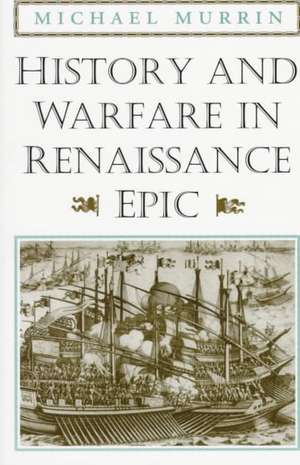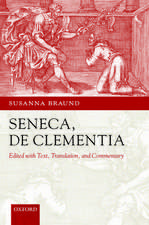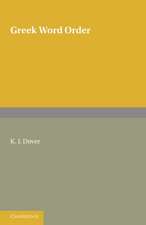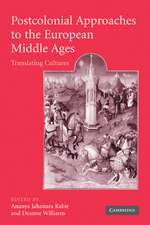History and Warfare in Renaissance Epic
Autor Michael Murrinen Limba Engleză Paperback – 9 iul 1997
Although the Renaissance epic was the principal literary means of representing war in its time, modern readers of the epic often lack a basic understanding of the history of warfare. Michael Murrin here offers the first analysis to bring an understanding of both the history of literature and the history of warfare to the study of the epic.
Analyzing English, Italian, and Iberian epics published between 1483 and 1610, Murrin focuses on particular aspects of warfare (cavalry clashes, old and new style sieges, the tactical use of the gun, naval warfare) and the responses to them by authors from Malory to Milton. Throughout, Murrin traces a parallel development in the art of war and in the epic as it emerged from the romance.
Murrin demonstrates that with new technology and increasing levels of carnage, the practice of war gradually drifted from traditional epic modes. But before changes in warfare completely doomed the tradition in which the epic was rooted, this crisis provoked an unprecedented range of experiment which marks heroic narrative in the late Renaissance and ultimately led to the epic without war.
A much-needed introduction to the neglected subject of warfare in epic literature, this work is an uncommonly wide-ranging exercise in comparative criticism that will appeal to historians and students of literature alike.
Analyzing English, Italian, and Iberian epics published between 1483 and 1610, Murrin focuses on particular aspects of warfare (cavalry clashes, old and new style sieges, the tactical use of the gun, naval warfare) and the responses to them by authors from Malory to Milton. Throughout, Murrin traces a parallel development in the art of war and in the epic as it emerged from the romance.
Murrin demonstrates that with new technology and increasing levels of carnage, the practice of war gradually drifted from traditional epic modes. But before changes in warfare completely doomed the tradition in which the epic was rooted, this crisis provoked an unprecedented range of experiment which marks heroic narrative in the late Renaissance and ultimately led to the epic without war.
A much-needed introduction to the neglected subject of warfare in epic literature, this work is an uncommonly wide-ranging exercise in comparative criticism that will appeal to historians and students of literature alike.
Preț: 322.55 lei
Nou
Puncte Express: 484
Preț estimativ în valută:
61.73€ • 63.77$ • 51.37£
61.73€ • 63.77$ • 51.37£
Carte tipărită la comandă
Livrare economică 25 martie-08 aprilie
Preluare comenzi: 021 569.72.76
Specificații
ISBN-13: 9780226554051
ISBN-10: 0226554058
Pagini: 388
Ilustrații: 8 halftones, 9 maps, 4 line drawings
Dimensiuni: 152 x 229 x 25 mm
Greutate: 0.52 kg
Ediția:1
Editura: University of Chicago Press
Colecția University of Chicago Press
ISBN-10: 0226554058
Pagini: 388
Ilustrații: 8 halftones, 9 maps, 4 line drawings
Dimensiuni: 152 x 229 x 25 mm
Greutate: 0.52 kg
Ediția:1
Editura: University of Chicago Press
Colecția University of Chicago Press
Cuprins
List of Illustrations
Acknowledgments
Abbreviations
Introduction
Pt. 1: War Without the Gun: The Romance Tradition
1: The Tactics of Roncesvalles: Luigi Pulci
2: Arthur's Rise to Power: Sir Thomas Malory
3: Agramante's War: Matteo Maria Boiardo
Pt. 2: The Movement Into Realism and History
4: The Siege of Paris: Ludovico Ariosto, Torquato Tasso, and Alonso de Ercilla y Zuniga
5: The Problems History Makes for the Poet: Torquato Tasso
Pt. 3: The Gun, Or the New Technology
6: Negative Critiques: Ludovico Ariosto and John Milton
7: Positive Evaluations: Alonso de Ercilla y Zuniga and Luis Vaz de Camoes
8: The Heroic Few: Alonso de Ercilla y Zuniga and Gaspar Perez de Villagra
9: The Officers Take Over: Juan Rufo and Pedro de Ona
Pt. 4: Violence
10: Are There Limits to Violence?: Matteo Maria Boiardo, Torquato Tasso, and Alonso de Ercilla y Zuniga
11: Acoma: Gaspar Perez de Villagra
Pt. 5: The Epic Without War
12: The English: Sir Philip Sidney, Michael Drayton, and Samuel Daniel
Appendixes
Notes
Bibliography
Index
Acknowledgments
Abbreviations
Introduction
Pt. 1: War Without the Gun: The Romance Tradition
1: The Tactics of Roncesvalles: Luigi Pulci
2: Arthur's Rise to Power: Sir Thomas Malory
3: Agramante's War: Matteo Maria Boiardo
Pt. 2: The Movement Into Realism and History
4: The Siege of Paris: Ludovico Ariosto, Torquato Tasso, and Alonso de Ercilla y Zuniga
5: The Problems History Makes for the Poet: Torquato Tasso
Pt. 3: The Gun, Or the New Technology
6: Negative Critiques: Ludovico Ariosto and John Milton
7: Positive Evaluations: Alonso de Ercilla y Zuniga and Luis Vaz de Camoes
8: The Heroic Few: Alonso de Ercilla y Zuniga and Gaspar Perez de Villagra
9: The Officers Take Over: Juan Rufo and Pedro de Ona
Pt. 4: Violence
10: Are There Limits to Violence?: Matteo Maria Boiardo, Torquato Tasso, and Alonso de Ercilla y Zuniga
11: Acoma: Gaspar Perez de Villagra
Pt. 5: The Epic Without War
12: The English: Sir Philip Sidney, Michael Drayton, and Samuel Daniel
Appendixes
Notes
Bibliography
Index

















